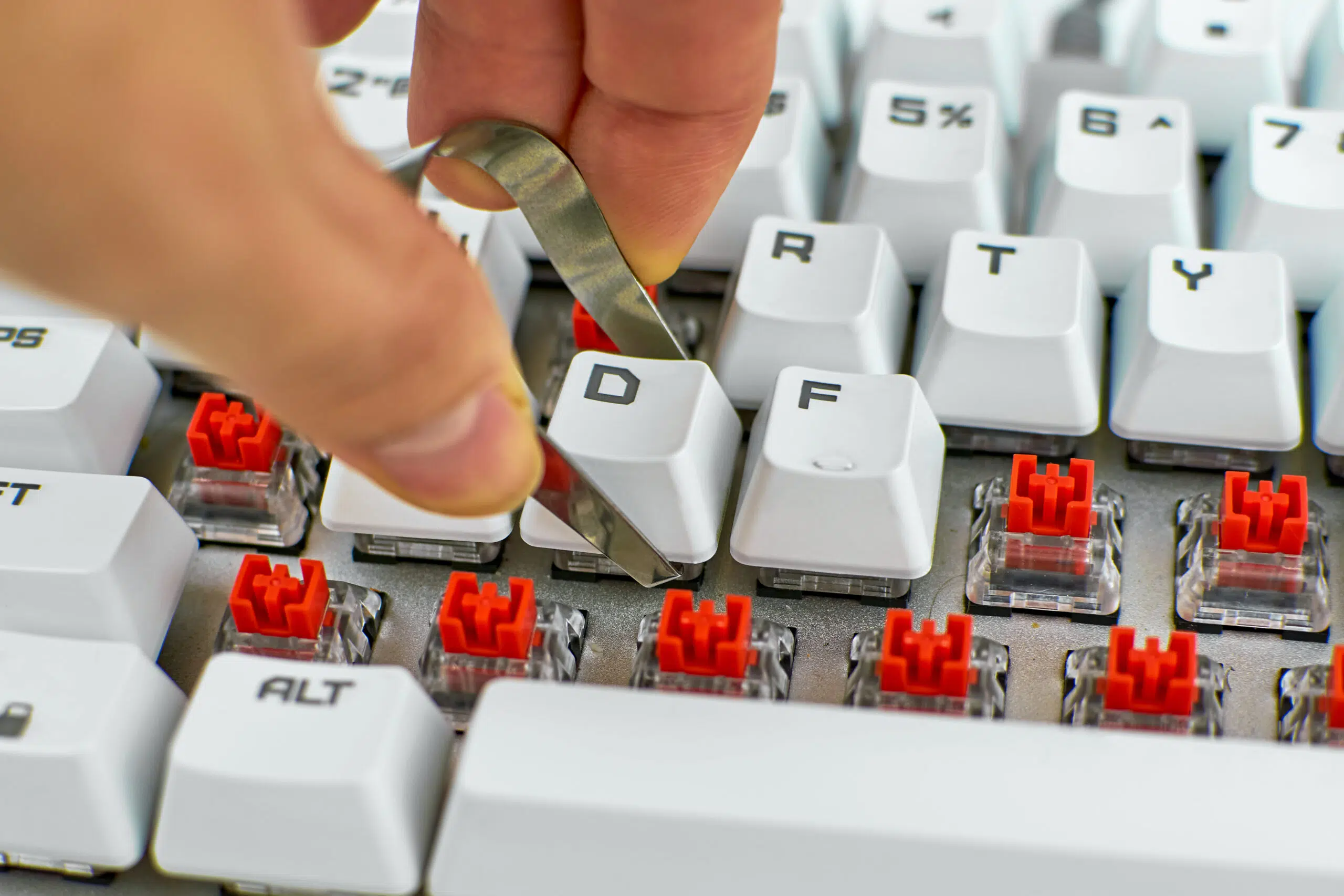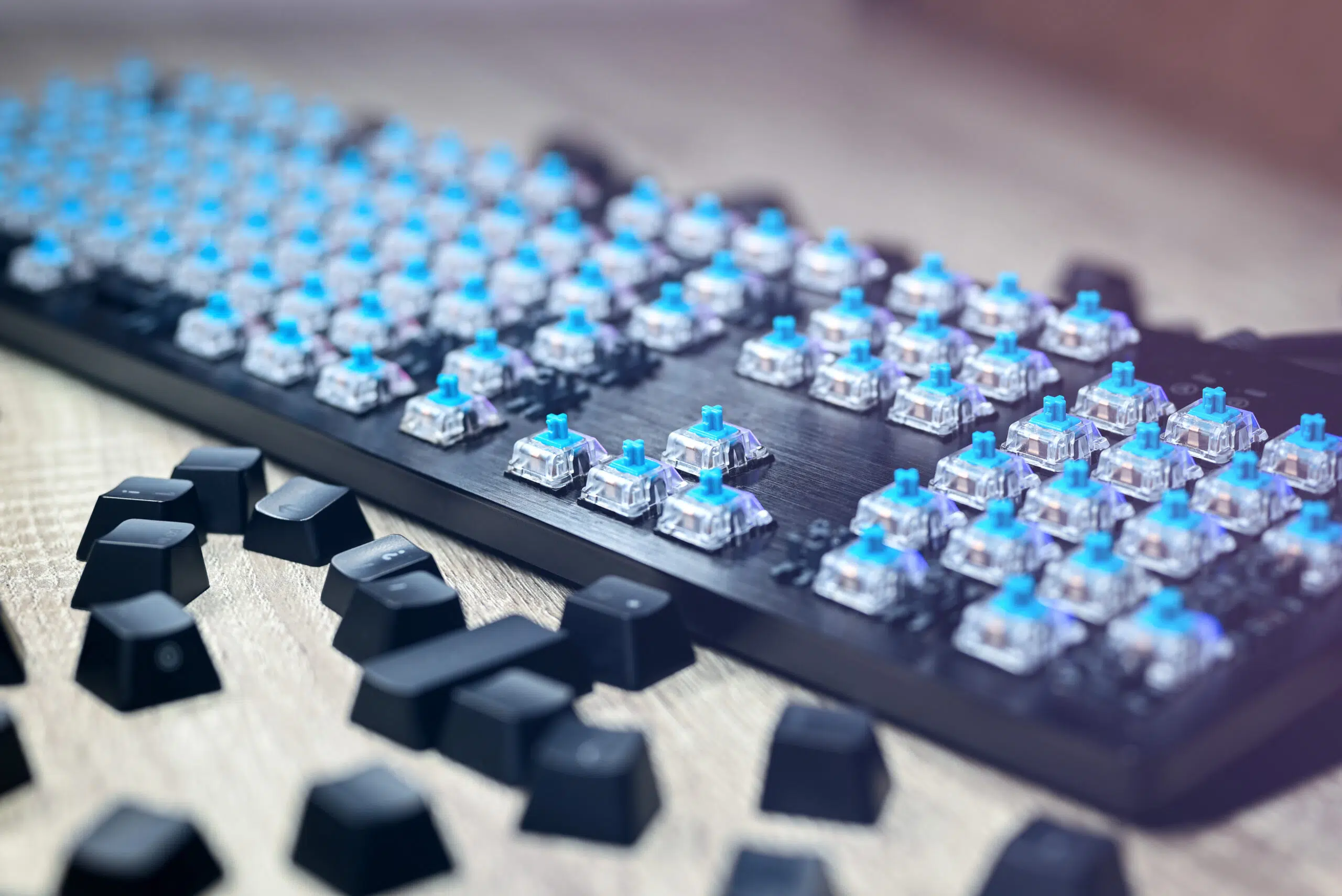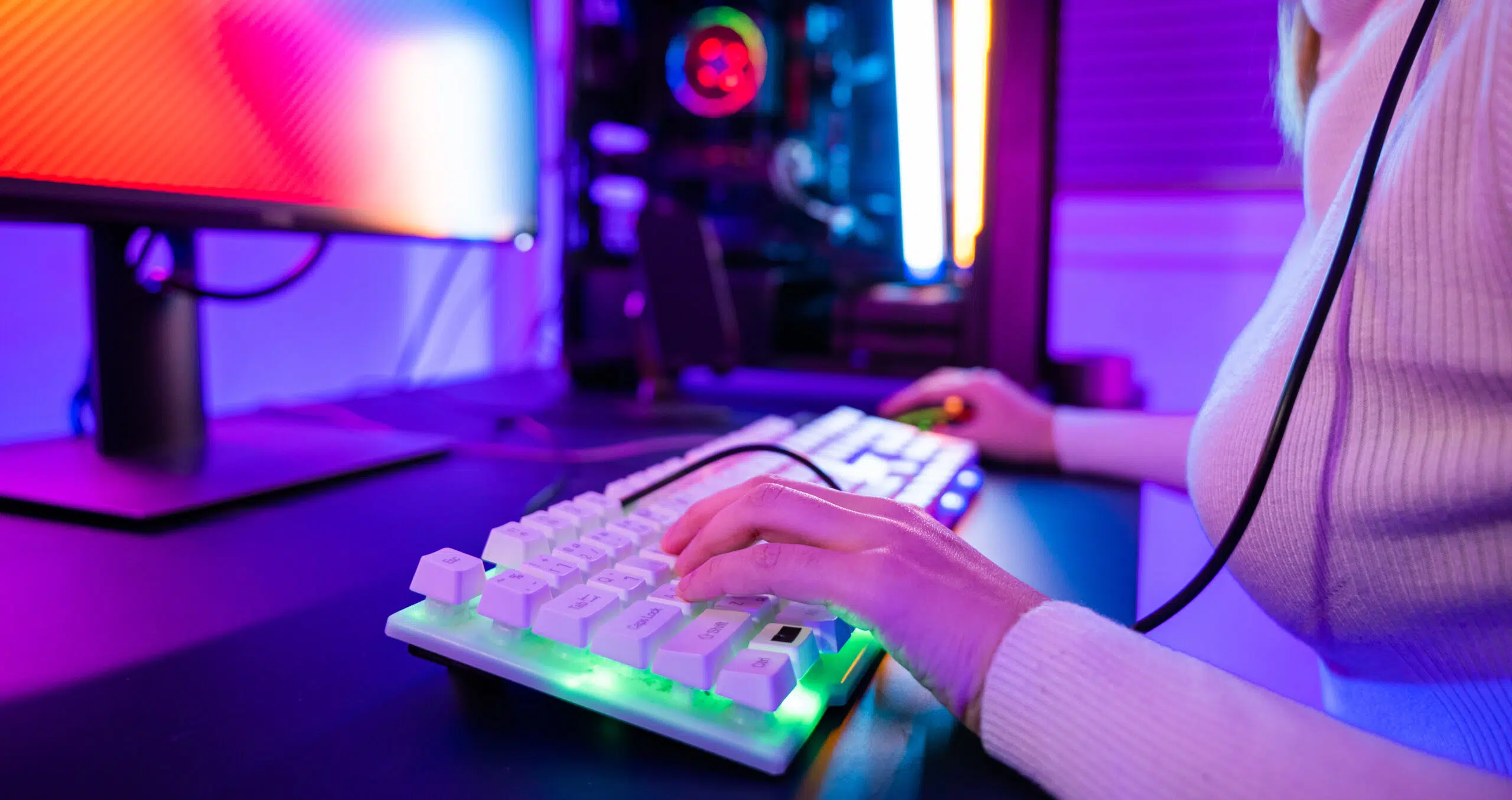Here’s everything about the keyboard’s switch type of the MacBook and MacBook Pro:
If your MacBook was produced between 2015 and 2019, you have butterfly switches.
Otherwise, you will have scissor switches which tend to be more reliable than butterfly switches as they are less likely to collect dirt.
Mechanical keyboards feature additional switch types known as linear, tactile, and clicky.
So if you want to learn all about the keyboard’s switch type of the MacBook and MacBook Pro, then you’re in the right place.
Let’s jump right into it!

What Are Keyboard Switches?

Let’s start at square one.
What even is a keyboard switch?
Well, it’s a mechanism that allows the computer to register when you press a key on a keyboard.
Specifically, when you press a button on a physical keyboard, your action is recorded by a device that is directly beneath the button.
That’s the switch. It’s a device that literally turns an electrical signal on or off, hence the name.
There are a few different design styles for keyboard switches, and that’s why you’ll see a variety of different options implemented across various computer platforms.
Many of the best keyboard switches (in terms of pure quality) are larger in size, so they don’t fit well in small keyboard designs (which are common among laptops).
This puts Apple engineers in a tight spot.
They want to live up to the quality expectations of Apple products and use the best switches, but they have to keep things compact enough to satisfy the user base.
As a result, Apple has flipped back and forth on switch types over the years.
So, if you want to know which keyboard switch is in your Mac, it will depend on the year it was manufactured.
I’ll break all of that down in complete detail, but first, I want to explain a little more about the different switches out there.
What Are the Common Types of Switches? (3 Kinds)

For most keyboard designs, there are two types of switches: scissor and butterfly.
I’ll break down each in its own section and provide a direct comparison between them.
It’s also worth noting that mechanical keyboards are a thing.
I’ll get into this a little later to broaden the context of this discussion.
If you use a mechanical keyboard, then there are three other switch types: linear, tactile, and clicky. We’ll get into all of that in a later section.
#1 Scissor Switches
Let’s talk about scissor switches first.
These switches are commonly found in laptops due to their low-profile design.
They take up less vertical space, so when you’re trying to make a laptop as thin as possible, scissor switches make a lot of sense.
At the cost of being thin, scissor switches provide a lot less feedback when you type.
For some people, that’s desirable, but with the rise in popularity of mechanical keyboards, feedback is in high demand.
To really understand how this kind of switch works, picture an “X.”
Now, imagine that the keycap for a letter on your keyboard is directly above that X.
So, the edges of the X under the cap line up with the four corners of the cap.
Now, when you press the key, the entire X is compressed.
When it goes all the way down, it comes into contact with a rubber dome in the inner workings of the keyboard.
That rubber dome connects directly to the circuit board in the keyboard.
Here’s what is happening.
The rubber actually interrupts a signal running through the keyboard circuits.
Because of that, the keyboard knows that a specific button was pressed.
Remember this, though.
Scissor switches don’t send a signal until they are fully compressed, so partial presses don’t send a signal.
#2 Butterfly Switches
Butterfly switches are definitely newer than scissor switches.
In fact, they were developed by Apple and patented in 2014.
Butterfly switches change up the entire switch design.
While a scissor switch has two distinct parts, the butterfly switch is a single-piece assembly.
The purpose of this switch was to lower the profile even more than what was possible with scissor switches.
As Apple was trying to make their computers even thinner, they came up with the butterfly switch as part of their solution.
To better understand how this type of switch works, picture a butterfly (yes, it’s aptly named).
The switch has two arms that go up and out, kind of like a shallow “V.”
The keycap rests on top of the V, and when it is pressed down, the sides of the V rotate downward.
So, the scissor switch lays flat and compresses when you push a key.
The butterfly switch is angled, and it bends down when the key is compressed.
As the butterfly bends, it sends a signal through the keyboard circuitry, denoting which key was pressed.
#3 Scissors vs Butterflies
Ok. Now that we’ve covered the mechanics of these switches, we can get into direct comparisons.
For the most part, scissor switches are better.
They were invented back in 1983, and over the years, they have seen a lot of development and improvement.
Meanwhile, Apple introduced the butterfly switch in 2014 and gave up on it in 2019.
Scissor switches are just more reliable.
The primary issue with butterfly switches is that they have gaps in them, and those gaps can collect dust and other small particles.
The debris can build up and mess with the switch (and therefore the keyboard) and its ability to work properly.
Meanwhile, scissor switches sit flat, and they don’t leave room for gunk to accumulate.
So, they stay clean, and that makes them more reliable.
How Can You Tell What Type of Switch Your MacBook Has?

That gives you a good idea of the battle between scissor and butterfly switches, but there are more questions that need answers.
How do you know which MacBooks have which type of switches?
Below, you’ll see a list of every model of MacBook that ever used a butterfly switch.
If your device isn’t on the list, then it uses a scissor switch.
- MacBook (Retina, 12-inch, Early 2015)
- MacBook (Retina, 12-inch, Early 2016)
- MacBook (Retina, 12-inch, 2017)
- MacBook Air (Retina, 13-inch, 2018)
- MacBook Air (Retina, 13-inch, 2019)
- MacBook Pro (13-inch, 2016, Two Thunderbolt 3 Ports)
- MacBook Pro (13-inch, 2017, Two Thunderbolt 3 Ports)
- MacBook Pro (13-inch, 2019, Two Thunderbolt 3 ports)
- MacBook Pro (13-inch, 2016, Four Thunderbolt 3 Ports)
- MacBook Pro (13-inch, 2017, Four Thunderbolt 3 Ports)
- MacBook Pro (15-inch, 2016)
- MacBook Pro (15-inch, 2017)
- MacBook Pro (13-inch, 2018, Four Thunderbolt 3 Ports)
- MacBook Pro (15-inch, 2018)
- MacBook Pro (13-inch, 2019, Four Thunderbolt 3 Ports)
- MacBook Pro (15-inch, 2019)
If you want more information, you can check the “About this Mac” entry in your MacBook.
What Type of Switch Do Newer MacBooks Use?

Earlier, I said that all MacBooks outside of the 2014-2019 window use scissor switches.
That is technically true, but there’s a little more to the story.
In 2020, Apple upgraded MacBook keyboards to what they call the Magic Keyboard.
The Magic Keyboard definitely uses a scissor switch, but Apple put some of their own engineering into it.
So, it’s a new and improved scissor switch.
To keep the explanation light, the new scissor switch is designed to maximize the tactile response of the Magic Keyboard.
Since people really like how it feels to use a mechanical keyboard, Apple tried to cater to that desire with a pseudo answer.
The Magic Keyboard is not a real mechanical keyboard, but it feels closer to one because of this redesigned scissor switch.
What About Mechanical Keyboards? (3 Design Styles)

That covers Apple keyboards, but if you want a broader context, then we should probably compare the scissor and butterfly switches to some non-Apple options out there.
I keep saying it; the most popular keyboards these days are mechanical keyboards.
There are a lot of different reasons for this.
Many professional gamers are of the opinion that mechanical keyboards are more responsive and provide better precision.
Many casual users just like the way they feel and sound.
Regardless, in order for mechanical keyboards to function as they do, they have to use different switches.
The defining characteristic of a mechanical keyboard is the spring-loaded fixture below each key.
This spring changes the feedback on the keyboard, giving it the tactile feel and sometimes loud clack that comes with pressing a button.
In order to make a switch that works with the spring mechanism, there are three design styles to choose from: linear, tactile, and clicky.
#1 Linear Switches
Linear switches are as aptly named as the other switches we have discussed so far.
They are made of straight lines.
A single stem moves up and down.
When the key is pressed, the stem is lowered, this connects to the circuit and sends the digital key signal.
A linear switch is similar in design to a butterfly switch, but because the linear switch is simpler, it doesn’t collect debris the same way.
This is the simplest and most reliable mechanical keyboard switch.
#2 Tactile Switches
Tactile switches are like linear switches, but they have a bump in the middle.
This allows the keystroke to register with a partial press.
For people trying to use their keyboards as fast as possible, tactile switches are more responsive, and they allow for faster typing or button pressing.
#3 Clicky Switches
Clicky switches are tactical switches, but they have an extra piece at the halfway point.
This piece exists solely to make noise.
Clicky switches actually provide the distinct “clack” sound you get with some of the noisier mechanical keyboards.
Some users like this audio feedback to help them recognize when a keystroke has successfully been sent through the keyboard circuitry.
Author
-

Tech entrepreneur and founder of Tech Medic, who has become a prominent advocate for the Right to Repair movement. She has testified before the US Federal Trade Commission and been featured on CBS Sunday Morning, helping influence change within the tech industry.
